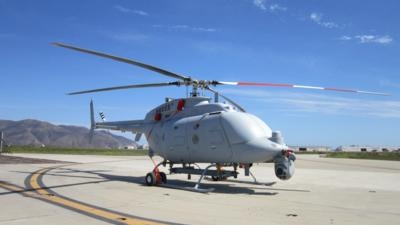Unmanned Systems To Play A Vital Role
Unmanned aircraft systems, or UAS, were a common theme during a May 6 “Future of Aviation” panel discussion featuring three Navy, Marine Corps and Coast Guard leaders at the 2019 Sea Air Space expo.

The Navy’s unmanned portfolio is rapidly expanding, and will soon include the world’s first carrier-based UAS, the MQ-25A Stingray. But unlocking the full potential of these systems requires that they communicate with and work alongside their fellow manned aircraft in the carrier air wing. “The future air wing is going to be lethal, survivable, networked, sustainable, and increasingly we have to benefit from manned-and-unmanned teaming,” said Angie Knappenberger, deputy director of air warfare in the Office of the Chief of Naval Operations.
Knappenberger noted that there are certain mission sets that might be adequately performed by autonomous aircraft, but that for complex warfighting scenarios, it’s best to “leverage some of that autonomy but still be in the loop with a manned system.”
To that end, the Navy has successfully tested scenarios where the MQ-8C Fire Scout rotary UAS seeks out targets for the MH-60 Seahawk manned helicopter. Knappenberger said the pairing is being reinforced by having MH-60 crews follow up their squadron tours with stints learning how to operate the Fire Scout. “You learn the business of both,” she said. “You understand the mission set better. You understand exactly how these two aircraft operate both independently and together.”
Knappenberger said the same philosophy will be applied to a second Navy manned-unmanned teaming, the MQ-4C Triton and P-8A Poseidon.
Though the Marine Corps already makes extensive use of small-to-medium-size UAS, the service wants a large, unmanned rotary-wing platform that can land and take off from amphibious ships, said Lt. Gen. Steven Rudder, Marine Corps deputy commandant for aviation. The future Marine Air-Ground Task Force (MAGTF) Unmanned Expeditionary system, or MUX, is still a little way off—Rudder said he hopes the system will be ready for early operational capability by 2026—but in the meantime, the service has narrowed down on the primary mission it would like MUX to perform. “What has risen to the top of the list is early warning, to be able to get out and process information for the maritime force,” Rudder said. “We are beginning to prioritize what we want the system to do, and we believe that system will be to create a network of early warning, [intelligence, surveillance and reconnaissance], and [signals intelligence]. We also need to balance exactly how far we want this thing to go,
because the strength of any unmanned system is the persistence that it applies. We could have a very capable platform with very low persistence, but we’d like to balance persistence with the systems it has on there.”
Meanwhile, the results since USCGC Stratton first deployed with the ScanEagle, a small reconnaissance UAS, in 2017—the seizure of more than 18 metric tons of cocaine across four deployments—have opened “a whole different paradigm for us,” said Vice Adm. Daniel Abel, the Coast Guard’s deputy commandant for operations.
In June 2018, the Coast Guard awarded a contract to the ScanEagle’s manufacturer to provide the UAS for all national security cutters. In addition, the Coast Guard is also exploring using the ScanEagle ashore, having completed a proof-of-concept in Puerto Rico before last month completing shore-based operations with the ScanEagle at the Texas-Mexico border, Abel said.
“It’s a game changer, shore and afloat,” he said.
Rudder also touched on the Future Vertical Lift (FVL) program, noting that the Marine Corps would prefer as its H-1 helicopter replacement a tiltrotor aircraft that could easily pair with the MV-22B Osprey. “We need something that can keep up with the V-22,” he said. “…Our sense is that a tiltrotor concept, we’re really interested in that speed-range capability.”
Rudder also expressed excitement over the planned deployment of Marine Corps F-35B Lightning IIs aboard HMS Queen Elizabeth (R08) during the new British carrier’s first operational tour. “It’s going to be a wonderful, new way, and I would offer, potentially, a new norm of doing coalition combined allied operations in a maritime environment,” he said.
As for the Navy’s ultimate replacement for the F/A-18 Super Hornet, the service just finished its analysis of alternatives for the Next Generation Air Dominance program, with results expected back later this year, Knappenberger said.
(Image provided with NAVAIR news release)
 ANN's Daily Aero-Term (04.25.24): Airport Rotating Beacon
ANN's Daily Aero-Term (04.25.24): Airport Rotating Beacon ANN's Daily Aero-Linx (04.25.24)
ANN's Daily Aero-Linx (04.25.24) Klyde Morris (04.22.24)
Klyde Morris (04.22.24) Airborne 04.24.24: INTEGRAL E, Elixir USA, M700 RVSM
Airborne 04.24.24: INTEGRAL E, Elixir USA, M700 RVSM Airborne 04.22.24: Rotor X Worsens, Airport Fees 4 FNB?, USMC Drone Pilot
Airborne 04.22.24: Rotor X Worsens, Airport Fees 4 FNB?, USMC Drone Pilot



